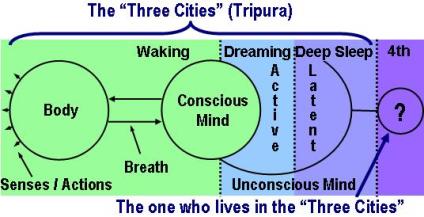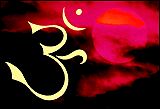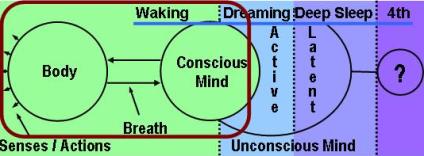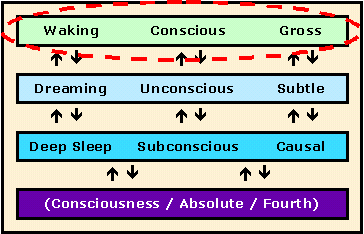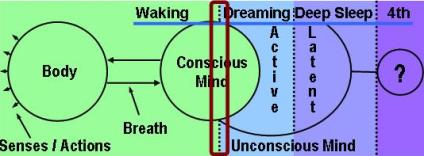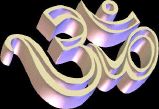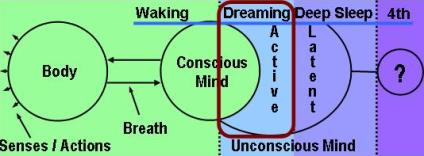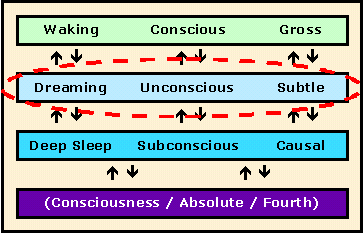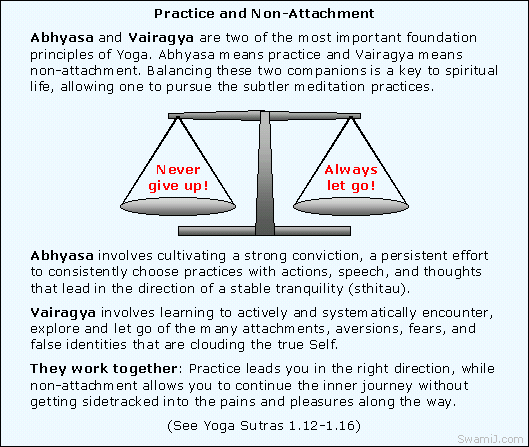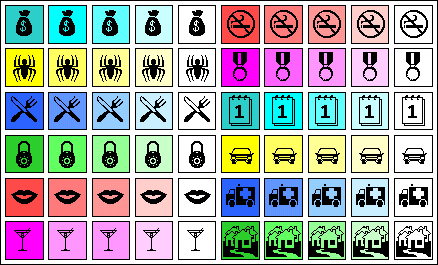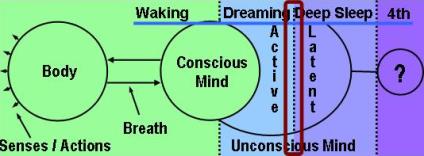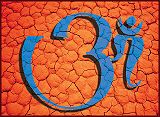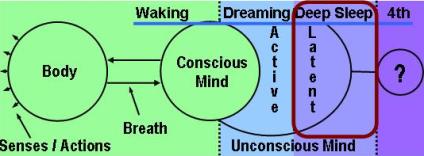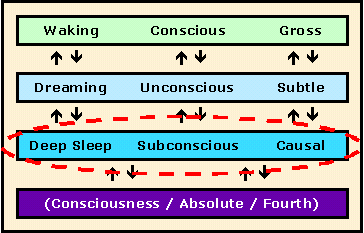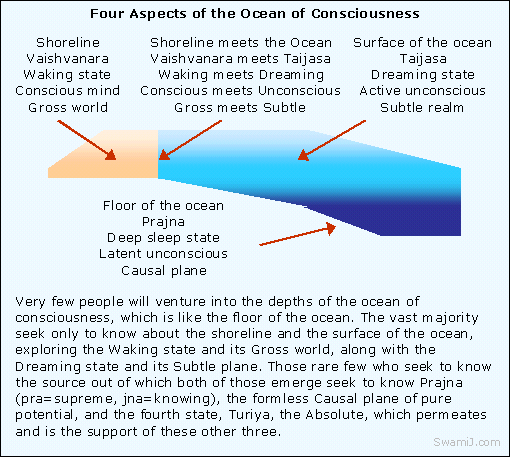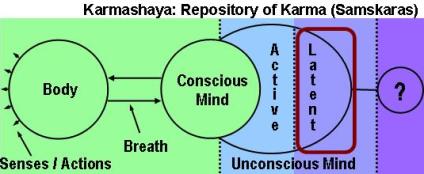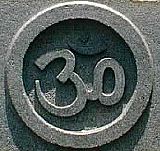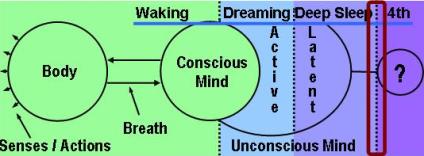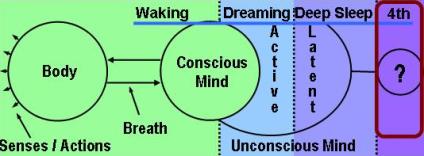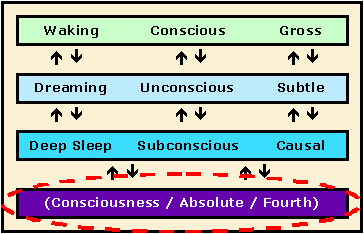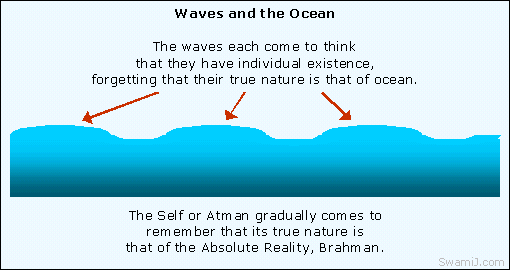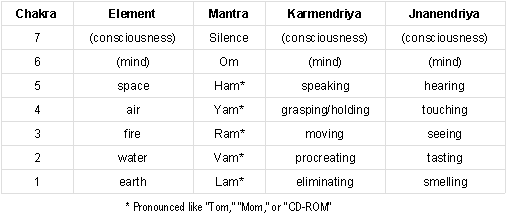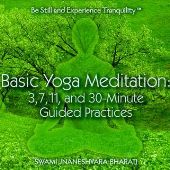|
|
OM Mantra and 7 Levels of Consciousness This artcle is available
in print: Seven Levels: The OM Mantra is a roadmap for sadhana, spiritual practices (written as either AUM or OM). It is not for the person who seeks only the shallow waters of spiritual life, but rather for those who strive to realize in direct experience the depth of the Absolute Reality. There are four main levels of consciousness outlined in the OM Mantra, along with three transition levels, which is a total of seven levels. Each of these is experienced on the inner journey of meditation and contemplation. See also Seven Methods of Practicing OM Mantra
Universal Realities: It is important to be aware of the fact that these levels of consciousness are realities that exist universally, regardless of whether or not one uses the OM Mantra or the visual OM symbol in any way. In either case, the underlying principles are extremely useful for all seekers in purifying or clearing the mind, and seeking the direct experience of deeper truths.
Contents
of this article: See
also these articles: Audio Podcast:
Mandukya Upanishad on Om Mantra: Yoga Vedanta Meditation More YouTube Videos by Swami J More MySpace Videos by Swami J
13 Tips on Mantra
in Yoga Meditation, Vedanta, and Tantra 7 States of consciousness in OM Mantra Seven states or levels of consciousness are described in this article:
See also: The four main levels of Consciousness (A, U, M, and Silence of OM Mantra) are also described in the article Levels and Dimensions of Consciousness. These levels exist universally: It is important to be aware of the fact that these levels of consciousness are realities that exist universally, regardless of whether or not one uses the OM Mantra or the visual OM symbol in any way. In either case, the underlying principles are extremely useful for all seekers in purifying or clearing the mind, and seeking the direct experience of deeper truths.
You can print the following and cut on the
dotted line to have a note
Other names for the four levels: Different texts and teachings might use different names for different characteristics at these four levels; for example, virat, hiranyagarbha, ishvara, and brahman, as well as vaishvanara, taijasa, prajna, and turiya.
Direct Experience Roadmap for direct experience: The Yogi does not use the information about these levels as mere intellectual fodder. Rather, the OM Mantra is a roadmap for sadhana, spiritual practices. It is not for the person who seeks only the shallow waters of spiritual life, but rather for those who strive to experience nothing less than the depth of the Absolute Reality in direct experience. 7
methods of practice: See the article: OM Mantra and Transpersonal Psychology:
For insight about conceptually bridging the levels of consciousness
outlined in the OM Mantra with the field of Transpersonal Psychology,
there is an article relating to the Needs Hierarchy developed by Abraham
Maslow: Yoga Sutras and OM Mantra
OM Mantra and other Mantras It is important to know that OM Mantra is very often used in conjunction with other mantras, usually with the OM being the first or last sound in the whole mantra. Often these other mantras refer to a specific deity or name of God. Some practitioners consider the OM to literally refer to only one such name of God or deity. Still other practitioners believe the OM refers to some different God or deity. For those born into such religious cultures, this diversity of use of OM is well known, and does not cause confusion, while also being aware that there may be discourses or debates supporting one view or another. However, others who are not familiar with this will benefit by becoming aware that there are a variety of ways of using OM Mantra. This leaves it a matter of personal choice how the OM Mantra will be used. Regardless of how one uses the mantra, there is a universal truth that the vibration of OM will be experienced on the inner journey. In that sense, is not a mere belief or symbolic tool belonging to any one group or groups. Similarly, the existence of waking, dreaming, sleep, and that beyond (described below as represented by AUM) are also universal realities. In the information below, OM Mantra is presented as a means of contemplation and meditation, which pierces the three levels of reality and consciousness, revealing the fourth, which permeates the other three.
Practicing the OM Mantra The OM Mantra (AUM Mantra; Pranava) is a widely recognized mantra. While the OM Mantra has a variety of meanings, one of its most significant uses is for Meditation and Contemplation in Yoga and Vedanta. The OM Mantra is recommended in the Yoga Sutras and the Mandukya Upanishad, as well as in many other teachings. Four major levels: When used in this way, the OM Mantra (AUM) has four major levels of meaning and experience to the Yogi.
Three transition stages: Between these four states of consciousness, there are three transition stages called Unmani, Aladani, and Samadhi.
Remember the four parts one after the other: Thus, in the use of the AUM Mantra, there are four levels of awareness that the Yogi wants to cultivate. The Yogi wants to remember the four parts of the AUM Mantra internally, one after the other, through the levels of consciousness. (The other three stages are also there, but these four are the main focus of the Yogi in using the OM Mantra). Remain aware of the meanings: With practice, it gradually becomes easier for one to maintain awareness of these meanings as attention moves through the parts of the AUM Mantra (The A, U, M, and Silence of OM Mantra). Over time, that awareness brings increasing insight of the true nature of these levels of consciousness. Eventually one moves to the direct experience of the Absolute Reality, that consciousness which permeates All (Silence after A, U, and M of OM Mantra). This is the state of Self-realization. Three functions are at the same level: One of the profound insights that one begins to get is the way in which 1) the levels of personal consciousness, 2) the stages of the mental process, and 3) the levels of the universe parallel one another. One comes to see that these three are functioning at the same levels of reality, which are none other than the levels of consciousness themselves. It is approximately like this:
In the actual practice with AUM Mantra (OM Mantra):
One of the other elegant and awesome insights is the way in which our own personality, mental and emotional processes operate:
AUM is like the three parts of a river: When recalling these levels of "A," "U," "M," and Silence during practice of the OM Mantra, it is useful to remember the metaphor of a river, which has three parts:
Consciousness at three levels: That reality or presence of existence itself, that is in the three levels of bed of the river, flow of the river, and surface of the river, is like the consciousness that permeates the three levels of Waking (A of OM Mantra), Dreaming (U of OM Mantra), and Deep Sleep (M of OM Mantra). Those three levels are also the Conscious (A of OM Mantra), Active Unconscious (U of OM Mantra), and Latent Unconscious or Subconscious (M of OM Mantra), as well as the Gross (A of OM Mantra), Subtle (U of OM Mantra), and Causal (M of OM Mantra) levels of reality.
Going beyond the three levels: Through practice, one gradually attains the ability to go beyond, or deeper than the various levels and thinking processes, to the direct experience of the source of the consciousness, symbolized by the Silence after the "A," "U," "M," of the OM Mantra. The practice begins simply, is practiced sincerely and faithfully, and expands over time, with ever increasing insights about the underlying truths contained in, and suggested by the OM Mantra. Meditation on OM (AUM) as an object of concentration, and Contemplation on its meaning work together in guiding one towards Self-realization.
This is a Tantric rendering of the three levels of consciousness mapped out by the OM Mantra symbol, and its levels of Vaishvanara (A of OM Mantra), Taijasa (U of OM Mantra), and Prajna (M of OM Mantra). Dedication, devotion, love, and surrender into this creative source or divine Mother is one of the finest aspects of Tantra as a direct route to Realization. Some conceptualize Tripura as an anthropomorphic deity, while the subtler practices are directed towards Tripura as formless, that fourth state beyond the other three cities (A, U, and M of OM Mantra). The Bindu of Sri Yantra is the symbol of this highest transcendent Reality (Silence of OM Mantra). The quality of the three cities is an aspect of OM Mantra, Gayatri Mantra, and Mahamrityunjaya Mantra.
Explanations of the 7 levels of consciousness: Below are some explanations of each of the seven levels of consciousness mapped out in OM Mantra. As you go through the levels of the OM Mantra described below, it is best to remember that the key levels for practice are awareness of the four levels of consciousness related to "A," "U," "M," and the fourth level of Silence. [Note: It is very useful to remember that, when describing or reading about subtle levels of consciousness, words are inadequate, and can easily seem to be in conflict with one another, as one wrestles with varying terminology, or with explanations from one or another writer. Ultimately, it is direct experience through repeated practice, without a break, over a long time that will unravel the meaning of the explanations and bring the true insights.]
1.
Waking / Conscious / "A" represents Waking: The Waking state of consciousness is represented by the "A" of the AUM Mantra. The name of this level of consciousness is Vaishvaanara. The Waking state (A of OM Mantra) is experienced by the individual person. In the Waking state of consciousness (A of OM Mantra) there are actions, speech, and thoughts of which we are "consciously" aware. The unconscious processes in the deeper levels (U and M of OM Mantra) are also there, but just not normally noticed.
Microcosm and macrocosm of Waking: If the individual person is the microcosm, then the whole of the manifest universe is the macrocosm. The "A" of AUM Mantra represents not only the individual Waking state of consciousness, but also the entire Gross realm. The individual state of Waking consciousness and the Gross realm are all operating at the same level of consciousness (both are "in the world"). The "A" bursts forth: When using AUM as a mantra, notice how the "A" bursts forth in an instant (whether said aloud, or thought of internally). You could say "Aaaaaaa...," in a drawn out way, but the "A" itself has a very brief, instantaneous bursting forth quality to it. The sound arises quickly, in a flash, from out of the silence. When using the OM Mantra, whether aloud or internally, it is useful to allow yourself to be aware of this bursting forth quality of thoughts, images, or impressions. All of these arise in a moment from the Subtler place within (U and M of OM Mantra). Three types of awareness with "A": In the practice of remembering the AUM Mantra, when awareness is on "A" of the OM Mantra, you cultivate and train yourself to have a simultaneous awareness of:
The awareness of these three operating at the same level of reality is allowed to become clearer through practice over time. Observing the "A" come forward: To observe the way the "A" comes forward when remembering the OM Mantra is to observe the way our whole process of thoughts, actions, and speech arises. This can be extremely useful to understand.
2.
Unmani / Transition Transition between Waking and Dreaming: There is a transition stage between Waking (A of OM Mantra) and Dreaming (U of OM Mantra) states (or between Conscious and Unconscious states). The name of this transition stage of consciousness is Unmani. Unmani does not just refer to the personal experience between Waking and Dreaming. Rather, it is the name of that transition level of consciousness itself. (Like many words, the word Unmani is used in different ways. In other contexts, it is also used to mean Samadhi or Turiya.)
We have all experienced this transition: We have all experienced this pleasant transition at times when about to awaken after a good sleep, and possibly when we are "day dreaming". In this state, you have left the Dreaming world (U of OM Mantra), but have not yet fully come into the Waking (A of OM Mantra), or external world. You might be lying there pleasantly, not remembering your name, who you are, where you are, and not really caring about these things. But you are also not asleep having any dreams. Increasing awareness of the transitions: When using the OM Mantra for Yoga Meditation and Contemplation, the focus is mostly on the three states of Waking (A of OM Mantra), Dreaming (U of OM Mantra), and Sleep (M of OM Mantra), which are also called the Gross, Subtle, and Causal. However, as it is practiced, there also will be a natural, increasing awareness of the transition phases as well. It will become clearer how it is that conscious (A of OM Mantra) thoughts, speech, and actions are transitioning from their underlying, mostly unconscious (U and M of OM Mantra) thought and emotional processes. Don't confuse this transition with Meditation: This very pleasant state is often confused with Meditation. Meditation is done in the Waking state (A of OM Mantra), in which one is full awake and alert. Then, gradually the veil is opened to allow the deeper states or levels (U of OM Mantra) to come forward into the Conscious, Waking state of awareness (A of OM Mantra). Parallels with science: In relation to the Gross world (A of OM Mantra), it is interesting to note the parallels between the transition between Unconscious and Conscious thought patterns, and the way the scientists describe the coming forth of the manifest universe as a "big bang". Possibly this too is a form of the coming forth of the Subtle (U of OM Mantra), transitioning into the Gross (A of OM Mantra).
3.
Dreaming / Unconscious / "U" represents Dreaming: The Dreaming state of consciousness is represented by the "U" of the AUM Mantra. The name of this level of consciousness is Taijasa(U of OM Mantra). Taijasa does not just mean dreaming. Rather, it is the name of that level of consciousness in which dreaming occurs (U of OM Mantra).
Mind working out its desires: The Dreaming state (U of OM Mantra) is a level where the mind can work out its unfulfilled wants, wishes, desires, attractions, and aversions not allowed to play out in the external world (A of OM Mantra). Both Yogis and psychologists speak of this as a useful process. Uncoloring thought patterns: However, the Yogi will go further in dealing with the underlying deep impressions (Samskaras) that lead to actions (Karmas). The Yogi wants to turn those colored (klishta) thought patterns uncolored (aklishta) thought patterns so that they no longer need to arise and cause disturbance, whether causing that disturbance in the Waking (A of OM Mantra) or Dreaming (U of OM Mantra) states of consciousness (See also the article on Klishta and Aklishta Thoughts). It is for this reason that the Yogi gradually and naturally needs less sleep; there are fewer colored (klishta) unconscious thought patterns needing to play out. (See Yoga Sutras 1.5, 2.1-2.9, and 2.10-2.11 on coloring and uncoloring) Microcosm and macrocosm of Dreaming: The counterpart of the personal Dream world (U of OM Mantra) is the entire Subtle, psychic, occult, or astral plane of reality (also U of OM Mantra). One is the microcosm, while the other is the macrocosm. Lifting the veil: As one progresses in Yoga Meditation, opening to the Unconscious (U of OM Mantra) begins. One stays in the Waking state (A of OM Mantra), but gradually lifts the veil, opens the curtain, so that the Unconscious (U of OM Mantra) begins to come forward. What comes is that which was normally only accessible in the Dreaming state (U of OM Mantra). Intentionally letting the thoughts come: It is in this field of observation that the Yogi does the Meditation of remaining one-pointed by letting go of the thought patterns arising. "Let them come, and let them go," is the message the Yogi says to the mind, as Non-Attachment (Vairagya) becomes a reality, not just an act done in the external world. (See Yoga Sutras 1.12-1.16 on non-attachment) The highest therapy: Gradually, the intensity of the coloring attenuates, eventually allowing the thought pattern to remain in latent, seed form (until it is dispensed with entirely). It is because of this process of attenuating that the Yogi says that Yoga Meditation is the highest of all therapies. (See Yoga Sutra 2.4 on attenuation) The coloring (klishta)
gradually attenuates
Taijasa is not the "spiritual" realm: This level of Taijasa (U of OM Mantra) has often been confused as being the "spiritual" realm, failing to note that it is only the second of four levels of consciousness in AUM Mantra (or third of the seven). If one is not familiar with this, it can seem that there are only two realms (a Gross and Spiritual) with a Transition between them. One can easily get caught in a trap of pursuing the actions, beings, and objects of the Subtle realm (U of OM Mantra), not recognizing that they are merely a level to move through, not a place to go and stay. Journeys in these subtle realms (U of OM Mantra) are no more useful in the journey of Self-realization than journeys to a thousand cities in our external world (A of OM Mantra), though some such journeying is sometimes needed so as to learn the lesson that the journeying is not needed. The article Realization Beyond the Gross and Subtle describes how it can seem that there are only two levels of Gross and Subtler. Seeking the Subtle is a distraction: Patanjali, codifier of Yoga science describes many siddhis (powers) that come to the Yogi through practices. Some say that the Yogi is seeking these powers intentionally. However, Patanjali actually mentions these on the foundation of Non-Attachment (Vairagya) and Discrimination (Viveka), such that the seeker will abandon these powers when they come (See Yoga Sutra 3.38). In other words, seeking of the breadth of the Subtle realm (U of OM Mantra) is a distraction on the journey to enlightenment; with Discriminative Wisdom and Non-Attachment, one is better off to let go of these allurements. Witnessing and going beyond: At the same time that the Yogi observes and lets go of the Subtle realm (U of OM Mantra), there is also a beauty in witnessing as one moves forward in the journey. We can surely enjoy the scenery along the way, though it may be best, the Yogis remind us, to move on to the Realization of the Absolute, which is not subject to death, decay, or decomposition. Awareness of the transition: In the practice of remembering the OM Mantra, one allows the awareness and feeling associated with the "A" to transition into the awareness and feeling associated with the "U". Three types of awareness with "U": In the practice of remembering the AUM Mantra, when awareness is on "U" of the OM Mantra, you cultivate and train yourself to have a simultaneous awareness of:
The awareness of these three operating at the same level of reality (U of OM Mantra) is allowed to become clearer through practice over time. Forming the sound of "U": The actual sound is not like the letter "A" and the letter "U," but is more like "AOOUUUUU...." There is "Ah," followed by "UUUUU..." (as in shOE). Then there is "MMMMM...." leading to Silence.
4.
Aladani / Transition Transition between Dreaming and Deep Sleep: There is a transition stage between Dreaming (U of OM Mantra) and Deep Sleep (M of OM Mantra) states. The name of this transition stage of consciousness is Aladani. Aladani does not just refer to the personal experience between Dreaming (U of OM Mantra) and Deep Sleep (M of OM Mantra). Rather, it is the name of that transition level of consciousness itself.
This transition is not normally experienced consciously: This is a state that one normally does not experience consciously. This state is very subtle. It is a transition (as is Unmani, between Waking and Dreaming, as described above), but is the transition whereby the latent, formless facts or impressions start to stir, and end up taking form in the Unconscious mind (U of OM Mantra), that part normally only accessed when one is having dreams while in the Dream state of sleep (U of OM Mantra). One may sometimes consciously experience the transition between Dreaming (U of OM Mantra) and Waking (A of OM Mantra), either while in bed at sleeping time or at Meditation time. This might be experienced as very beautiful or very horrifying, depending on the nature of the thought patterns. However, the transition at Aladani is very different from the Waking (A of OM Mantra) to Dreaming (U of OM Mantra) transition. Thoughts in their formless form: Here, in the Aladani transition, the thought patterns that are in their unmanifest, formless, latent form start to stir. This is literally the beginnings of the enlivening of latent Samskaras, the source of our Karma (the word Karma literally means "actions"). It is a process that one is not normally conscious of. Once again, it is very important to note that this is not the same as the process whereby Unconscious active mental process springs forward through Unmani into the Waking or Conscious state; this is happening at a deeper level. Beyond the Gross and Subtle: As attractive as the Gross and Subtle realm can be, these levels beyond Taijasa (the Dream State or Subtle realm) can be even more alluring and distracting. As one touches on this transition phase from which the Subtle realm and Subtle thoughts are born, one starts to see the way in which both the subtle and material realm are manifested and can be manipulated. Aladani and Aladin's lamp: Notice the similarity between the names of the level of consciousness called Aladani and the story of Aladin's lamp, wherein there was a genie. The genie was in latent form, but by rubbing the lamp, a transition process begins whereby the genie comes forth to fulfill any wishes. Between the stage of the genie being inside the lamp, and being fully formed, the transition of the genie is that of smoke that changes and solidifies into form. Moving past this transition level: For one truly on the path of Self-realization, this is a level to be acknowledged and moved past, allowing the stirrings to fall back to rest so that the Absolute can be experienced.
5.
Deep Sleep / Subconscious / "M" represents Deep Sleep: The Deep Sleep state of consciousness is represented by the "M" of the AUM Mantra. The name of this level of consciousness is Prajna. Prajna does not just mean Deep Sleep (M of OM Mantra). Rather, it is the name of that level of consciousness in which one experiences Deep Sleep (M of OM Mantra).
Impressions are stored in their latent form: The Deep Sleep state (M of OM Mantra) is the level where deep impressions are stored in their latent form. It contains the roots of our habit patterns, the Samskaras that are the driving force behind Karma (actions). Those wants, wishes, desires, attractions, and aversions that play themselves out in dreams (U of OM Mantra), or turn into actions and speech in the external world (A of OM Mantra) have their root in this level of consciousness. Those impressions are like seeds, lying there waiting for water and fertilizer to awaken them, so they may grow in the fields of Dreaming (U of OM Mantra) or Waking (A of OM Mantra). Prajna is supreme knowledge: "Pra" means "Supreme" and "Jna" comes from "Jnana," which means "Knowledge". Thus, Prajna (M of OM Mantra) is the level of consciousness that is of Supreme Knowledge (M of OM Mantra). How odd it is, that the domain of Deep Sleep (M of OM Mantra), where there seems to be nothing going on, is called the place of Supreme Knowledge. Prior to the creation of thoughts and emotions: However, Prajna (OM of OM Mantra) is the place, the level that is deeper than, or prior to the creation of thoughts and emotions, whether in the Dream (Unconscious; U of OM Mantra) level or the Waking (Conscious; A of OM Mantra) level. Prior to the manifestation of Gross and Subtle: It is also the domain that is deeper than, or prior to creation or manifestation (M of OM Mantra) of the objects and activities within both the Subtle (U of OM Mantra) and Gross (A of OM Mantra) realms. (The phrase "prior to" is not meaning in the sense of time. Rather, it is that out of which the next thing emerges. A metaphor sometimes used is the way that a pot comes out of clay. Here, the clay is always there. Out of the clay emerges the pot, and although the clay never goes away, the pot will go away, and merge back into the clay from which it came.)
Infinite library of wisdom: One who begins to gain access to this Prajna level (M of OM Mantra) also begins to gain access to what has been called the Infinite Library of Wisdom. This means direct experience of knowing, not merely from some form of contact with the Subtle realm (U of OM Mantra), but with the level out of which that Subtle realm arises. Storage and altering of samskaras: In this level of Prajna (the level of Deep Sleep; M of OM Mantra) is the storage of the formless, latent thought patterns (formless forms) called Samskaras that drive Karma, or action (A of OM Mantra). If one can gain access to the Samskaras (M of OM Mantra) while they are in this latent form, they can be more readily altered such a way that they lose their potency. Making samskaras mere memories: Then, having lost their power (or reduced it substantially), the deep habit patterns, or Samskaras (M of OM Mantra), can no longer bind one to what would otherwise automatically drive actions, speech, and thoughts. Now, those deep impressions (M of OM Mantra) have become mere memories with little or no power. It is like a rope that before could bind, but that has now been burned. Though maybe still having the shape of a rope, it has lost its ability to bind. (This process is definitely not one of psychological suppression or repression.) Gaining direct access to the samskaras: There are a variety of techniques that professional and lay people use at the Waking level (A of OM Mantra) to indirectly affect changes in these deep impressions. Some of these can be very useful to spiritual aspirants in their journey. However, the Yogis want direct access to these deep impressions (M of OM Mantra) so that they can choose their own deep habit patterns. In this way, the Yogi gradually becomes a master over the Samskaras (M of OM Mantra) leading to his or her own thoughts, speech, and actions. Burning away the colorings: For the Yogi, this is a process of dealing with the roots of habits directly, through Yoga Meditation, Contemplation, and Yoga Nidra (described below). While the Yogi definitely cultivates the creation of new habit patterns, it is not merely pasting on another layer of habits on the top of the old, whereby one is left with inner conflict between the old and the new habits or Samskaras (that can play out unconsciously into actions and speech, as well as inner turmoil). The Yogi wants to attenuate and then burn away the colorings of fears, aversions, attractions, egoism, and spiritual ignorance (M of OM Mantra). Microcosm and macrocosm of Deep Sleep: These personal latent impressions or Samskaras are the microcosm, while the macrocosm is the Causal plane (M of OM Mantra) from which creation of the entire Subtle (U of OM Mantra) and and Gross (A of OM Mantra) universe emerges. This is why it is called the "Causal" realm or level of reality (M of OM Mantra). Those with great access to this level are sometimes revered, although even this attainment is short of the Self-realization that comes with the realization of Turiya, the Absolute Reality (Silent aspect of OM Mantra). The Yogis suggest that the aspirant turn away even from the allurement of the offer of such creative powers, and instead walk in the pursuit of the Highest Realization. Three types of awareness with "M": In the practice of remembering the AUM Mantra, when awareness is on "M," you cultivate and train yourself to have awareness of:
The awareness of these three operating at the same level of reality (M of OM Mantra) is allowed to become clearer through practice over time. Prajna and Yoga Nidra: This level of Deep Sleep (M of OM Mantra), or Prajna, is the level at which Yoga Nidra, or Yogic Sleep is directed (Some incorrectly believe that Yoga Nidra is directed towards the transition level of Unmani, #2 above. That is only an early experience on the way to true Yoga Nidra). In Yoga Meditation and
Contemplation, one remains in the Conscious,
Waking state (A of OM Mantra), and gradually allows that Waking state to expand
through the other states that are normally unconscious. However, in Yoga Nidra one
leaves the Waking state, descends to the Deep Sleep state Reducing samskaras through Yoga Nidra: Yoga Nidra is a state which allows one to experience thought patterns directly in their latent, hidden, or formless forms, and thus be able to reduce their power to play out due to habit. The phenomena itself of reducing the power of the Samskaras comes about naturally through the deep process of introspection during Yoga Nidra. That level of consciousness is the M of OM Mantra.
6. Samadhi / Deep Absorption Beyond Waking, Dreaming, and Deep Sleep: Beyond, or below Waking, Dreaming, and Deep Sleep (the A, U, and M of OM Mantra) is the state of deep absorption, that is the stage to which one's Meditation practice next leads. It is called Samadhi.
Many types of Samadhi: There are many forms of Samadhi. An even cursory review of the texts will reveal dozens of different types. Mostly, these differences have to do with the nature of the object on which one was meditating before dropping into the state of Samadhi with that object. Meditation on Gross or Subtle: The Object on which one is meditating (and then enters Samadhi) may be Gross or Subtle. A simple example will help. If one is internally meditating on the image of a red rose, that object is a Gross object (the A of OM Mantra). Meditation may shift away from the red flower to the red color alone, the "redness". However, even that is still a Gross object of sorts. However, if attention shifts to light itself, or to the ability to see light, those are subtler (the U of OM Mantra). If attention shifts deeper to the observer who is doing the observing, or to the blissful feeling that comes from the absorption, then these are still subtler. However, in any case there is still an "object," although that object may be extremely subtle. Similarly, Meditation on a spiritual or religious object will also move through levels of experience, from Gross to Subtle, to Subtler, and to Subtle-most (the A, U, and M of OM Mantra). Eventually the inward shifting of attention reveals the essence of the object of Meditation and Samadhi. Observer, observing, and observed collapse into one: In Meditation on an object, whether Gross or Subtle, there are three parts: 1) An Observer, 2) A Process of Observing, and 3) The Object being observed. With Samadhi, it is as if these three parts collapse into only one. There is no longer an observer observing the observed; rather, there seems to be only the object. It is as if the observer and the process of observing have become absorbed into the object, such that object is the only thing left. Samadhi with, or without form: There are two general categories of Samadhi. One is Samadhi "with form" or "with object" (of which there are many types of gross or subtle objects, and thus many types of Samadhi). During Meditation, attention was directed towards this form or object, and in Samadhi, the attention becomes absorbed into that form or object. The other category is Samadhi "without form" or "without object," in which there is attention that is not directed towards any form or object (since it is without any object or form, there is not the diversity of types of Samadhi, as is the case with Samadhi on form or object). In both categories of Samadhi, the attention stance is similar. The difference is that in the case of objectless or formless Samadhi, there is no object. The stance of attention is still there, but the object is not. It is somewhat as if during Samadhi with form, one had simply forgotten the object, and thus came into objectless Samadhi. Cultivating Practice and Non-attachment: For one who does not get trapped by the activity of the Gross world, the Subtle realm, or even the stirrings of the formless Causal level, then the state of absorption called Samadhi is within reach. Attaining Samadhi rests on two foundation principles, Practice and Non-Attachment, Abhyasa and Vairagya.
7.
Turiya / Consciousness / Silence represents the permeating consciousness: After the "A," the "U," and the "M" of the OM Mantra there is Silence that is representative of the consciousness that permeates, and is all of the other levels. The name of this level of consciousness is Turiya. (All other mantras merge into the vibration of OM, and in turn, to this Silence.)
Turiya means "the fourth": Turiya literally means "the fourth," and represents that consciousness which permeates, observes, and is the other three levels. To call Turiya a "level" is not really accurate, since it is always, in fact, witness of, and at one with, the other states.
Standing on the roof of the building: From the vantage point of Turiya, one sees the entire panorama of the play of the levels of consciousness. It has been likened to standing on the roof of a three floor building, where the first three floors are the Waking, Dreaming, and Deep Sleep states (Gross, Subtle, Causal levels) . From those levels, you can only look out a window, whereas from the roof you can see it all. Practicing the AUM Mantra: The AUM Mantra represents the four states of Waking, Dreaming, Deep Sleep, and the fourth state of Turiya. These four are the focus of attention in remembering the OM Mantra. The Transition states and the Samadhi state are less focused on with intention during the practice. This does not mean they are not there, or will not be experienced, but simply that one not making specific use of them in Meditation and Contemplation. In practicing the OM Mantra, the emphasis is on the "A," the "U," the "M," and the Silence, along with their associated realities. Practice with the Silence after AUM: In the practice of remembering the AUM Mantra, when awareness is on the Silence after the "A," the "U," and the "M," you cultivate and train yourself to have an awareness of that consciousness, and that it:
Consciousness permeates, is the foundation of, and in fact, is the whole of the levels of the "A," the "U," and the "M" levels. This awareness is allowed to become clearer through practice, over time.
Merging into stillness and silence: Many sages, teachers, and traditions have pointed out that eventually all light, sound and mantras lead to Stillness and Silence. By understanding the meaning of AUM and OM Mantra, and the levels of consciousness that it represents, it becomes much easier to see how it is that light, sound and mantras truly do merge back into the Stillness and Silence from which they arose. The meaning of AUM is revealed: The masters, sages, teachers, and traditions have also pointed out that to really understand this, one must do the practices and go to the Stillness and Silence oneself, wherein the meaning of AUM Mantra is revealed.
Distinction between Samadhi and Turiya: There is a fine distinction between Samadhi and Turiya. Samadhi is a dualistic style of attention, while Turiya is non-dualistic, leading one to the experience "I am That," or Self-realization. There are many objects on which one can practice Yoga Meditation and enter Samadhi, and there are Gross, Subtle, and Subtler levels of objects in which one might attain Samadhi, as well as objectless Samadhi. However,
Turiya brings one to Self-realization that, "I am a Wave in the Ocean
of Bliss; I and the Ocean are One; I am Ocean; I am That".
Mandukya
Upanishad: The pinnacle of the wisdom of the ancient sages is contained in the terse twelve verses of the Mandukya Upanishad, which outlines the philosophy and practices of the OM mantra (written as either AUM or OM). It has been said that the wisdom of the ancient sages is in the four books of the ancient most text the Vedas, the juice of the Vedas is in the Upanishads, and the juice of the Upanishads is in the Mandukya Upanishad. The entire subject of Mandukya Upanishad is AUM Mantra. It has also been widely said that if one understands and practices Mandukya Upanishad, no other teachings are needed. While nobody is likely to do that, the statement is a clear comment on the strength of this wisdom and practice. OM Mantra is also suggested as a direct route to samadhi in the Yoga Sutras (See Yoga Sutras 1.23-1.29).
Mandukya Upanishad on Om Mantra: Yoga Vedanta Meditation The teachings of the Mandukya Upanishad and OM Mantra are well worth deep study, discussion, reflection and contemplation. By faithfully and intently engaging these twelve verses, all of the other written and oral teachings can be explored as expansions of the foundation principles and practices encapsulated in this succinct summary. The OM Mantra is a roadmap of the entire process of sadhana and a most practical tool for Self-Realization. To have such a terse summary as the centerpiece of practices, it makes the context of all other practices significantly easier to understand and actually do. It is not only a most insightful writing, but also a complete outline for sadhana, enlightenment practices.
Audio Podcast:
The Self and the Absolute (1-2): 1)
Hari Om. Om-ity-etad-aksharam-idam sarvam, tasyopavyākhyānam
bhūtam bhavad bhavishyaditi sarvam-omkāra eva. Yaccānyat
trikālātītam tadapy omkāra eva.
All is OM: Hari Om. The whole universe is the syllable Om. Following is the
exposition of Om. Everything that was, is, or will be is, in truth Om.
All else which transcends time, space, and causation is also Om.
2)
Sarvam hyetad brahmāyam-ātmā brahma soyamātmā
catushpāt.
Atman has Four Aspects: All of this, everywhere, is in truth Brahman, the Absolute Reality.
This very Self itself, Atman, is also Brahman, the Absolute Reality.
This Atman or Self has four aspects through which it operates. Four
Levels of Consciousness (3-7):
3) Jāgarita-sthāno
bahish-prāj˝ahsaptānga ekonavimsatimukhah sthūla-bhug vaiśvānarah
prathamah pādah.
First is Waking / Gross: The first aspect of Atman is the Self in the Waking state,
Vaishvanara. In this first state, consciousness is turned outward to the
external world. Through its seven instruments* and nineteen channels* it
experiences the gross objects of the phenomenal world. 4)
Svapna-sthāno'ntah-prāj˝ah saptānga ekonavimsatimukhah
praviviktabhuk taijaso dvitīyah pādah.
Second is Dreaming / Subtle: The second aspect of Atman is the Self in the Dreaming state, Taijasa.
In this second state, consciousness is turned towards the inner world.
It also operates through seven instruments and nineteen channels, which
engage the subtle objects of the mental realm. 5)
Yatra supto na kancana kāmam kāmayate na kancana svapnam pasyati
tat sushuptam. Sushupta-āsthāna ekibhūtah praj˝ānaghana
evānandamayo hyānandabhuk chetomukhah prājnastrityah pādah.
Third is Deep Sleep / Causal: The third aspect of Atman is the Self operating in the Deep Sleep
state, Prajna. In this third state, there is neither the desire for any
gross or subtle object, nor any dream sequences. In deep sleep, all such
experiences have receded or merged into the ground of undifferentiated
consciousness. Here, one is filled with the experience of bliss, and can
also find the way to clearer knowledge of the two preceding states. 6)
Esha sarvesvara esha sarvaj˝a esho'ntaryāmy-esha yonih sarvasya
prabhavāpyayau hi bhūtānām.
Find the Experiencer: The one who experiences all of these states of consciousness is the
omniscient, indwelling source and director of all. This one is the womb
out of which all of the other emerge. All things originate from and
dissolve back into this source. 7)
Nantah-prāj˝am na bahih-prāj˝am, nobhayatah-prāj˝am na
prāj˝ana-ghanam na prāj˝am naprāj˝am. Adrishtam-avyavahārayam-agrāhyam-
alakshanam-acintyam-avyapadesyam-ekātma-pratyayasāram,
prapancopasarnam santam sivam-advaitam caturtham manyante sa tm sa
vijneyah.
The Fourth Aspect is Turiya: The fourth aspect of Atman or Self is Turiya, literally the fourth.
In this fourth state, consciousness is neither turned outward nor
inward. Nor is it both outward and inward; it is beyond both cognition
and the absence of cognition. This fourth state of Turiya cannot be
experienced through the senses or known by comparison, deductive
reasoning or inference; it is indescribable, incomprehensible, and
unthinkable with the mind. This is Pure Consciousness itself. This is
the real Self. It is within the cessation of all phenomena. It is
serene, tranquil, filled with bliss, and is one without second. This is
the real or true Self that is to be realized.
Four
Aspects of AUM (8-12): 8)
So'yam-ātmā adhyaksharam-omkaro dhimātram pādā mātrā
mātrāsca pādā akāra ukāro makāra iti.
Those Four are the Same with "A-U-M" and Silence:
That Om, though described as having four states, is indivisible; it
is pure Consciousness itself. That Consciousness is Om Mantra. The three sounds
A-U-M (ah, ou, mm) and the three letters A, U, M
are identical with the three states of waking, dreaming, and sleeping,
and these three states are identical with the three sounds and letters.
The fourth state, Turiya is to be realized only in the silence behind or
beyond the other three.
9)
Jagarita-sthāno vaiśvānaro'kārah prathamā mātrā.
āpterādimatvād-vāpnoti ha vai sarvān kāmānādisca
bhavati ya evam veda.
The Sound "A" is Waking / Gross: Vaishvanara is the consciousness experienced during the waking state,
and is A, the first letter of Om Mantra. That simple sound of A
is first and permeates all other sounds. One who is aware of this first
level of reality has fulfillment of all longings and is successful. 10)
Svapna-stāhnas taijasa ukāro dvitīyā mātrotkarshādu-ubhayatvād-
votkarsāti ha vai j˝āna-santatim samānasca bhavati nāsyābrahmavit
kule bhavati ya evam veda.
The Sound "U" is Dreaming / Subtle: Taijasa is the consciousness experienced during the dreaming state,
and is U, the second letter of Om Mantra. This intermediate state
operates between the waking and sleeping states, reflecting some
qualities of the other two. One who knows this subtler state is superior
to others. For one who knows this, knowers of Brahman, the Absolute
Reality, will be born into his family. 11)
Sushupta-sthnah prāj˝o makras tritīya mtr miterapīter va
minoti ha va idam sarvam-apītisca bhavati ya evam veda.
The Sound "M" is Deep Sleep / Causal: Prajna is the consciousness experienced during the state of
dreamless, deep sleep, and is M, the third letter of Om Mantra. It
contains the other two, and is that from which the other two emerge, and
into they recede or merge. A knower of this more subtle state can
understand all within himself. 12)
Amātras-caturtho'vyavahāryah prapancopasamah sivo'dvaita
evamomkara ātmaiva samvisaty-ātman-ātmānam ya evam
veda.
Silence after "A-U-M" is the True Self: The fourth aspect is the soundless aspect of Om
Mantra. It is not utterable
and is not comprehended through the senses or by the mind. With the
cessation of all phenomena, even of bliss, this soundless aspect becomes
known. It is a state of nondual (advaita) realityŚone without a
second. This fourth state, Turiya, is the real Self or true Self. One
with direct experience of this expands to Universal Consciousness. *Twenty-Six
Principles (from verses 3-4):
The
seven instruments are the more macrocosmic instruments, while the
nineteen channels relate more to the microcosmic, individual person.
Seven Instruments: First,
Consciousness manifests outward as space, air, fire, water, and
earth, along with the individuation from the whole and the flow of
energy (which we know as the pulsing impulse towards breath).
Nineteen Channels: Then, the
individual operates through the four functions of mind (aspects of
antahkarana, the inner instrument), which are manas, chitta, ahamkara, and buddhi. Those
four operate through the five pranas (prana, apana, samana, udana,
and vyana), the five active senses or indriyas (karmendriyas of
eliminating, procreating, moving, grasping, and speaking), and the
five cognitive senses (jnanendriyas of smelling, tasting, seeing,
touching, and hearing)
See also these articles: These are explored in meditation and
contemplation: All of these seven instruments and nineteen channels
are the means by which the Self or Atman operates in the external
world, which is Vaishvanara, the subject of this third verse of the
Mandukya Upanishad. It is extremely useful, if not essential, to
understand and remember these twenty-six principles, instruments, or channels. This
is not just intellectual information, but rather, is a real key to the
self-observation and self-awareness practices that lead to the
transcendence of all of these, and the realization of the Self. If they
are not conscientiously witnessed, one can be deprived of the depths of
spiritual awakening. Keeping
it simple: When reading about these twenty-six principles (the seven
instruments and nineteen channels), it can seem very complicated.
However, please keep in mind that the entire process of inner
functioning is being mapped out in these principles. From that
perspective, twenty-six is really not such a large number. By
systematically learning about, exploring, witnessing, and transcending
those few, you find yourself at the realization of the Self, the Atman,
which is the goal described in other verses of the Mandukya Upanishad.
Five
elements: The five elements of earth, water, fire, air, and space
are literally examined during meditation and contemplation, as well as
witnessed in daily life. The five elements operate in conjunction with
the lower five chakras (at subtle level they are called tanmatras, which
are part of tattvas, or subtle constituents). The five elements align
with, and operate from the five lower chakras, along with the ten
indriyas
and a seed mantra for each.
See also these links on the Five
Elements: Five pranas: When the Prana
operates in the body, it divides into five major flows called Vayus. These
can be thought of as somewhat like major currents in one of the large
oceans of the world, while there may be thousands of smaller currents.
These five Vayus are the major currents that contain thousands of
smaller currents. The five are literally witnessed and examined during
meditaition and contemplation.
Prana Vayu operates from the
heart area, and is an upward flowing energy, having to do with
vitalizing life forces.
Apana Vayu operates from the
base of the torso, in the rectum area, is a downward flowing energy,
and has to do with eliminating or throwing off what is no longer
needed.
Samana Vayu operates from the
navel area, deals with digestion, and allows the mental
discrimination between useful and not useful thoughts.
Udana Vayu operates from the
throat and drives exhalation, operating in conjunction with Prana
Vayu, which deals with inhalation.
Vyana Vayu operates
throughout the whole body, having no particular center, and is a
coordinating energy throughout the various systems.
See also these links on the Five
Pranas: Ten Senses or Indriyas: The
human being is like a building with ten doors. Five are entrance doors,
and five are exit doors. Witnessing these ten senses is an
important part of meditation, contemplation, and meditation in action.
Karmendriyas:
The five exit doors are five means of expression, which are called
Karmendriyas (Karma means action: Indriyas are the means or senses).
Jnanendriyas:
The five entrance doors are the five cognitive senses, which are
called Jnanendriyas (Jnana means knowing; Indriyas are the means or
senses).
See also the extensive
article on the Indriyas. Four functions of mind: The four
functions of mind are manas, chitta, ahamkara and buddhi. To witness these
four is a tremendous practice for advancing in meditation.
Manas = sensory, processing mind
Chitta = storage of impressions
Ahamkara = "I-maker" or
Ego
Buddhi = knows, decides, judges,
and discriminates
See also the article: Four
Functions of Mind.
Witnessing: There is an extensive
article on Witnessing Your Thoughts, which
includes many of the seven instruments and nineteen channels outlined here
in the Mandukya Upanishad.
-------
|
||||||||||||||||||||||||||||||
|
|
|||||||||||||||||||||||||||||||




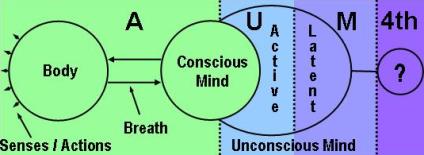
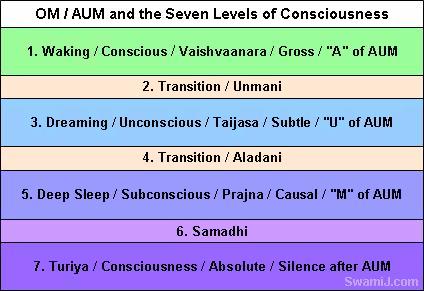



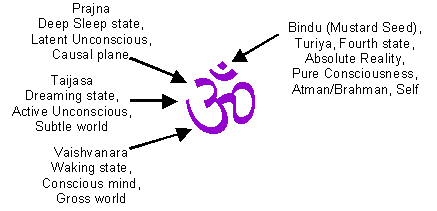
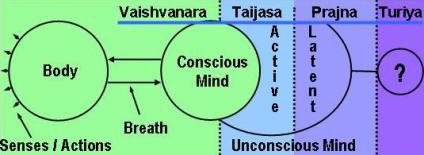


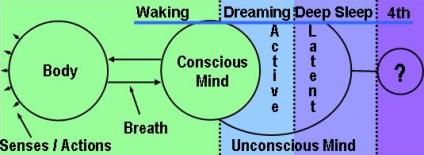
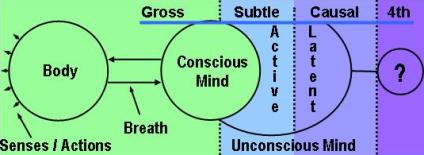
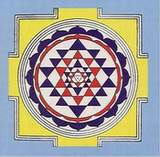 Tripura: Tri means three,
and pura means city. Tripura is the consciousness
that operates in the three cities of Waking (A of OM Mantra), Dreaming
(U of OM Mantra), and Deep
Sleep (M of OM Mantra), as well as the Conscious (A of OM Mantra), Unconscious
(U of OM Mantra), and Subconscious (M of OM Mantra) aspects of
mind. Sometimes conceptualized as the divine feminine (Shakti), compared
to the divine masculine (Shiva), she permeates the three cities of
the Gross world (A of OM Mantra), the Subtle plane (U of OM Mantra), and the Causal reality
(M of OM Mantra). Tripura
also permeates the many other trinities such as the beingness inherent in
past, present and future.
Tripura: Tri means three,
and pura means city. Tripura is the consciousness
that operates in the three cities of Waking (A of OM Mantra), Dreaming
(U of OM Mantra), and Deep
Sleep (M of OM Mantra), as well as the Conscious (A of OM Mantra), Unconscious
(U of OM Mantra), and Subconscious (M of OM Mantra) aspects of
mind. Sometimes conceptualized as the divine feminine (Shakti), compared
to the divine masculine (Shiva), she permeates the three cities of
the Gross world (A of OM Mantra), the Subtle plane (U of OM Mantra), and the Causal reality
(M of OM Mantra). Tripura
also permeates the many other trinities such as the beingness inherent in
past, present and future.
